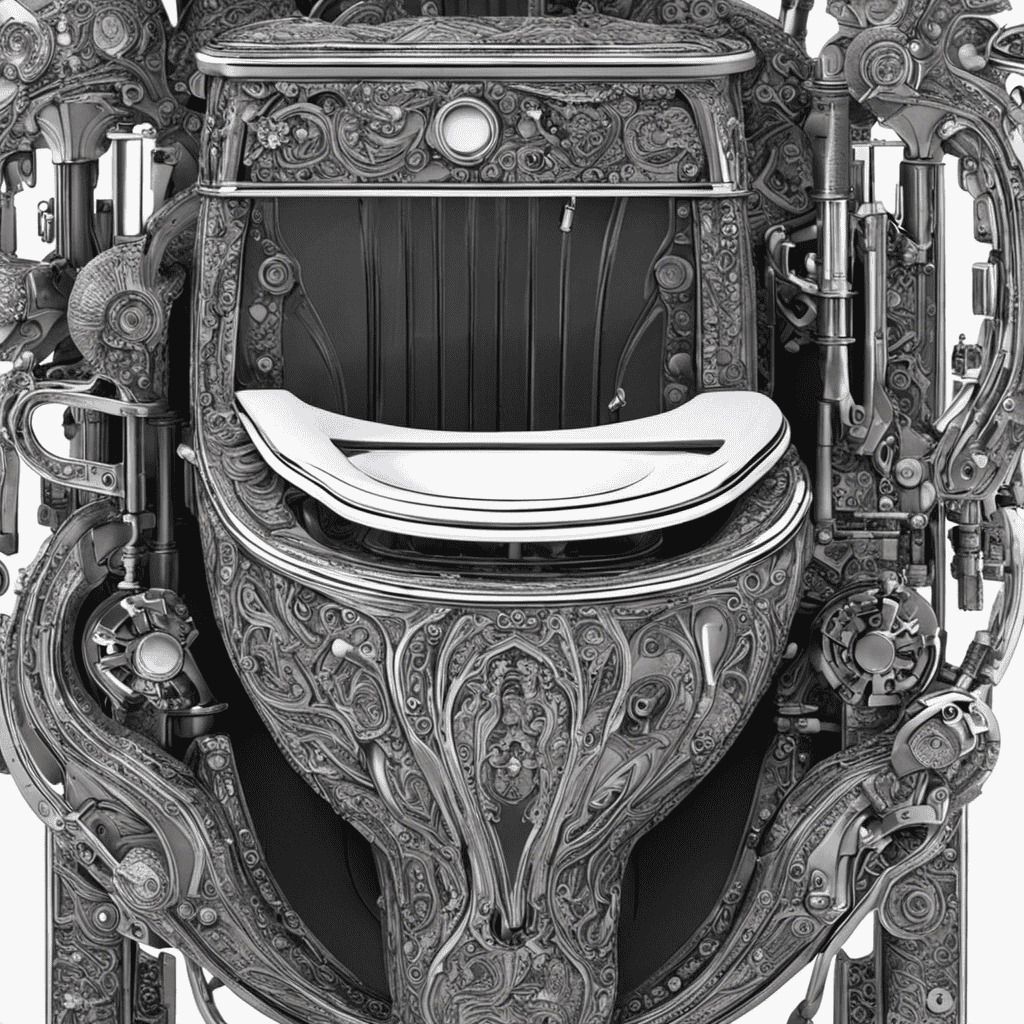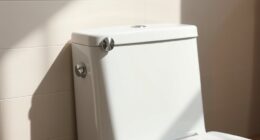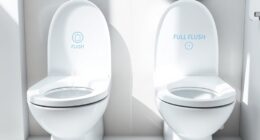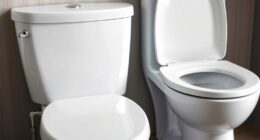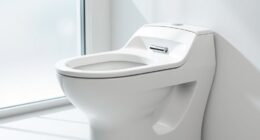Maintaining a flawless toilet may seem like an impossible task, but fear not! With this comprehensive guide, I will walk you through the steps to ensure your porcelain throne remains in pristine condition.
From routine cleaning to leak inspections, bolt checks, seal examinations, and handle tests, I will equip you with the knowledge and techniques needed to keep your toilet functioning flawlessly.
Get ready to conquer the world of toilet maintenance and serve your household like never before!
Key Takeaways
- Incorporate routine cleaning and sanitizing techniques into your bathroom maintenance schedule.
- Regularly perform a flush test and check for leaks to ensure proper functionality and prevent water wastage.
- Conduct regular leak inspection and bolt check to ensure a stable toilet seat and prevent water damage.
- Regularly inspect and replace the toilet seal to maintain a watertight connection and prevent water damage and odors.
Routine Cleaning
I always make sure to incorporate routine cleaning into my bathroom maintenance schedule to keep my toilet sparkling clean.
When it comes to sanitizing techniques, I find that using a combination of cleaning products is the most effective way to eliminate germs and bacteria.
To start, I use a toilet bowl cleaner that’s specifically designed to remove tough stains and kill 99.9% of bacteria. I apply the cleaner under the rim and let it sit for a few minutes before scrubbing the bowl with a toilet brush.
For the rest of the toilet, I use a multi-purpose cleaner that’s safe for porcelain surfaces. I spray the cleaner on a microfiber cloth and wipe down the seat, lid, and exterior of the toilet. This helps to remove any dirt or grime and leaves the toilet looking clean and fresh.
With these sanitizing techniques and the right cleaning products, maintaining a spotless toilet is a breeze.
Flush Test
To ensure proper functionality, it’s important to regularly perform a flush test and check if the toilet is flushing efficiently. This not only helps maintain a clean and hygienic bathroom environment but also promotes toilet water conservation.
Here are three common flushing mistakes to avoid:
-
Flushing unnecessary items: Only flush toilet paper and human waste. Items like wipes, cotton balls, or dental floss can clog the pipes and cause plumbing issues.
-
Continuous flushing: Flushing multiple times for the same waste is wasteful and can lead to water wastage. Ensure everything is flushed in one go by using the appropriate water volume and holding the flush handle until the flush cycle is complete.
-
Ignoring leaks: A leaking toilet can waste a significant amount of water over time. Check for leaks by adding a few drops of food coloring to the tank and see if it appears in the bowl without flushing. If there’s a leak, get it fixed promptly.
Leak Inspection
While conducting a leak inspection, it’s essential to check for any signs of water leakage around the toilet base or in the tank. Water damage prevention is crucial in maintaining the integrity of your plumbing system and avoiding costly repairs.
As a provider of plumbing repair services, I prioritize identifying and fixing leaks promptly to prevent further damage. To begin the inspection, I carefully examine the toilet base for any water stains, dampness, or discoloration. If I notice any signs of leakage, I proceed to inspect the toilet tank.
I check the water level and listen for any continuous running sounds, which could indicate a faulty flapper valve or fill valve. Additionally, I inspect the supply line connections and ensure they’re tight and free from any leaks.
Bolt Check
When it comes to maintaining a flawless toilet, one crucial step is performing a regular bolt check.
Checking the tightness of the bolts that secure the toilet to the floor is essential to prevent any wobbling or movement, which can lead to leaks or damage.
Additionally, inspecting the bolts for signs of corrosion is vital to ensure their longevity and reliable performance.
Tightening Loose Bolts
I can easily tighten loose bolts to ensure a secure toilet seat. Here’s how:
- Gather the necessary tools: a wrench, pliers, and a screwdriver.
- Locate the loose bolts underneath the toilet seat.
- Use the wrench to tighten the bolts by turning them clockwise. Be careful not to overtighten, as this may damage the seat or the toilet itself.
Proper bolt installation is crucial for maintaining a stable toilet seat. If the bolts are damaged or worn out, it’s important to replace them promptly. To do this, follow these steps:
- Remove the old bolts using pliers or a screwdriver.
- Insert the new bolts into the designated holes.
- Tighten the nuts onto the bolts using the wrench, ensuring a secure fit.
By addressing loose bolts and ensuring proper bolt installation, you can prevent accidents and ensure a comfortable experience for users.
Now, let’s move on to discussing bolt corrosion prevention.
Bolt Corrosion Prevention
To prevent bolt corrosion, regular inspections and applying a protective coating are essential maintenance tasks. Corrosion, caused by exposure to moisture and chemicals, can weaken the bolts and compromise the structural integrity of the equipment.
During inspections, look for signs of corrosion such as discoloration, pitting, or rust. If corrosion is present, it must be addressed promptly to prevent further damage. Corrosion removal can be achieved by using a wire brush or sandpaper to gently scrub away the corroded areas.
Once the bolts are clean, applying a protective coating, such as a rust inhibitor or a waterproof sealant, will help prevent future corrosion. Additionally, consider using alternative materials for bolts, such as stainless steel or coated materials, which are more resistant to corrosion.
Seal Examination
I’m going to check the seal on the toilet to ensure it’s in good condition. The toilet seal is an essential component that prevents leaks and keeps the bathroom clean and hygienic.
Here are the common seal problems to watch out for:
-
Leaks: If you notice water pooling around the base of the toilet, it may indicate a faulty seal. This can lead to water damage and unpleasant odors.
-
Cracks: Over time, the seal can develop cracks, which compromise its effectiveness. Cracks can occur due to age, shifting of the toilet, or improper installation.
-
Wear and Tear: The toilet seal is constantly exposed to moisture and chemicals, which can cause deterioration. Regular inspection is necessary to identify signs of wear and tear.
If you encounter any of these issues, it’s crucial to consider toilet seal replacement. A new seal will ensure a watertight connection and maintain the integrity of your bathroom.
Handle Test
The handle’s functionality and durability are crucial, so regularly performing the handle test ensures it can effectively flush the toilet. As a professional plumber, I understand the importance of proper handle maintenance to avoid inconvenience for our customers. To assist you in handling handle replacement and troubleshooting, I have prepared a handy table below:
| Issue | Possible Causes |
|---|---|
| Loose handle | Loose mounting nut or worn-out handle mechanism |
| Handle doesn’t flush | Damaged lift chain or misaligned flapper |
| Handle sticks | Build-up of mineral deposits or corroded handle mechanism |
To troubleshoot handle-related problems, start by checking for a loose handle and tighten the mounting nut if necessary. If the handle doesn’t flush, inspect the lift chain for damage or adjust the flapper alignment. In case the handle sticks, clean any mineral deposits on the handle or replace the mechanism if it’s corroded. Remember, regular handle testing and maintenance will help keep your toilet in optimal working condition, ensuring a hassle-free experience for your customers.
Frequently Asked Questions
How Often Should I Clean My Toilet to Prevent Any Buildup and Maintain It in a Flawless Condition?
To keep my toilet in flawless condition, I clean it regularly to prevent any buildup. By following the best practices for toilet maintenance, I ensure its optimal performance.
Using reliable toilet cleaning products, I remove any stains, odors, and bacteria. Regular cleaning prevents the accumulation of mineral deposits and keeps the toilet bowl sparkling clean.
This simple yet essential task ensures a hygienic and well-maintained toilet for a worry-free experience.
What Should I Do if My Toilet Fails the Flush Test and Doesn’t Flush Properly?
If my toilet fails the flush test and doesn’t flush properly, there are a few troubleshooting steps I can take.
First, I’ll check if there’s a clog in the toilet bowl or the drain pipe. If I don’t see any visible blockages, I’ll inspect the flapper valve and ensure it’s sealing properly.
Another common issue could be a problem with the fill valve or the water level in the tank.
How Can I Identify if There Is a Leak in My Toilet and What Steps Should I Take to Fix It?
Toilet leak detection is crucial for maintaining a functional bathroom. First, check for any visible signs of leakage, like water pooling around the base or a constantly running toilet.
Next, perform a dye test by adding food coloring to the tank and checking for colored water in the bowl.
If a leak is detected, the toilet repair process involves identifying the source, such as a faulty flapper or fill valve, and replacing the damaged component.
What Should I Do if the Bolts Holding My Toilet in Place Are Loose or Damaged?
What do you do when the bolts holding your toilet in place are loose or damaged?
Well, the first step in DIY toilet repair is to identify the issue. Loose or damaged bolts can cause your toilet to wobble or leak.
To fix this problem, you’ll need to replace the toilet bolts. This can be done by removing the old bolts and installing new ones securely.
Make sure to tighten them properly to ensure a stable and leak-free toilet.
How Can I Determine if the Seal Between the Toilet and the Floor Is Faulty and Needs to Be Replaced?
To determine if the seal between the toilet and the floor is faulty and needs to be replaced, there are a few signs to look out for.
Firstly, if you notice any water pooling around the base of the toilet or a persistent odor, it could indicate a leak.
Additionally, if the toilet wobbles or moves when you sit on it, it’s likely that the seal is compromised.
These are all indications that it’s time for a toilet seal replacement.
Conclusion
In conclusion, maintaining a flawless toilet is essential for the overall hygiene and functionality of your bathroom. By following the routine cleaning, flush test, leak inspection, bolt check, seal examination, and handle test outlined in this comprehensive guide, you can ensure that your toilet remains in optimal condition.
Imagine the frustration of a leaky toilet causing water damage to your bathroom floor and the inconvenience of constantly having to call a plumber. By investing a little time and effort in regular maintenance, you can avoid such scenarios and enjoy a trouble-free toilet experience.



